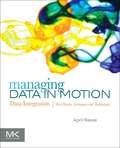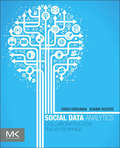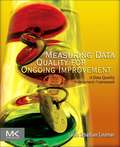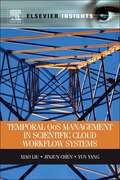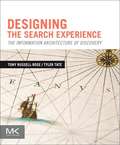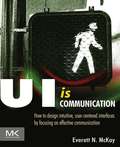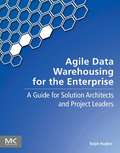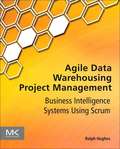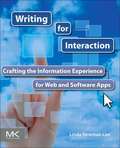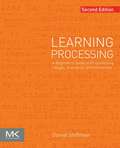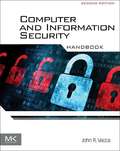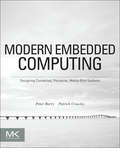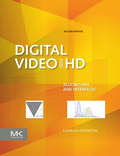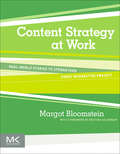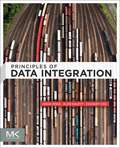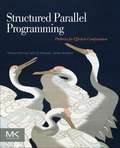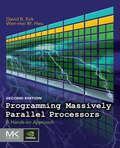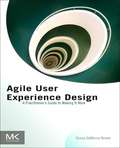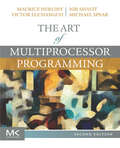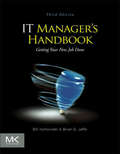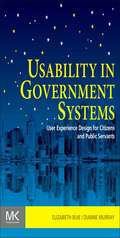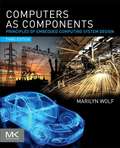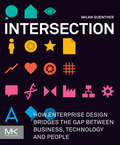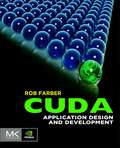- Table View
- List View
Managing Data in Motion: Data Integration Best Practice Techniques and Technologies (The Morgan Kaufmann Series on Business Intelligence)
by April ReeveManaging Data in Motion describes techniques that have been developed for significantly reducing the complexity of managing system interfaces and enabling scalable architectures. Author April Reeve brings over two decades of experience to present a vendor-neutral approach to moving data between computing environments and systems. Readers will learn the techniques, technologies, and best practices for managing the passage of data between computer systems and integrating disparate data together in an enterprise environment. The average enterprise's computing environment is comprised of hundreds to thousands computer systems that have been built, purchased, and acquired over time. The data from these various systems needs to be integrated for reporting and analysis, shared for business transaction processing, and converted from one format to another when old systems are replaced and new systems are acquired. The management of the "data in motion" in organizations is rapidly becoming one of the biggest concerns for business and IT management. Data warehousing and conversion, real-time data integration, and cloud and "big data" applications are just a few of the challenges facing organizations and businesses today. Managing Data in Motion tackles these and other topics in a style easily understood by business and IT managers as well as programmers and architects.Presents a vendor-neutral overview of the different technologies and techniques for moving data between computer systems including the emerging solutions for unstructured as well as structured data typesExplains, in non-technical terms, the architecture and components required to perform data integration Describes how to reduce the complexity of managing system interfaces and enable a scalable data architecture that can handle the dimensions of "Big Data"
Social Data Analytics: Collaboration for the Enterprise (The Morgan Kaufmann Series on Business Intelligence)
by Krish Krishnan Shawn P. RogersSocial Data Analytics is the first practical guide for professionals who want to employ social data for analytics and business intelligence (BI). This book provides a comprehensive overview of the technologies and platforms and shows you how to access and analyze the data. You'll explore the five major types of social data and learn from cases and platform examples to help you make the most of sentiment, behavioral, social graph, location, and rich media data. A four-step approach to the social BI process will help you access, evaluate, collaborate, and share social data with ease. You'll learn everything you need to know to monitor social media and get an overview of the leading vendors in a crowded space of BI applications. By the end of this book, you will be well prepared for your organization’s next social data analytics project.Provides foundational understanding of new and emerging technologies—social data, collaboration, big data, advanced analyticsIncludes case studies and practical examples of success and failuresWill prepare you to lead projects and advance initiatives that will benefit you and your organization
Measuring Data Quality for Ongoing Improvement: A Data Quality Assessment Framework (The Morgan Kaufmann Series on Business Intelligence)
by Laura Sebastian-ColemanThe Data Quality Assessment Framework shows you how to measure and monitor data quality, ensuring quality over time. You’ll start with general concepts of measurement and work your way through a detailed framework of more than three dozen measurement types related to five objective dimensions of quality: completeness, timeliness, consistency, validity, and integrity. Ongoing measurement, rather than one time activities will help your organization reach a new level of data quality. This plain-language approach to measuring data can be understood by both business and IT and provides practical guidance on how to apply the DQAF within any organization enabling you to prioritize measurements and effectively report on results. Strategies for using data measurement to govern and improve the quality of data and guidelines for applying the framework within a data asset are included. You’ll come away able to prioritize which measurement types to implement, knowing where to place them in a data flow and how frequently to measure. Common conceptual models for defining and storing of data quality results for purposes of trend analysis are also included as well as generic business requirements for ongoing measuring and monitoring including calculations and comparisons that make the measurements meaningful and help understand trends and detect anomalies. Demonstrates how to leverage a technology independent data quality measurement framework for your specific business priorities and data quality challengesEnables discussions between business and IT with a non-technical vocabulary for data quality measurementDescribes how to measure data quality on an ongoing basis with generic measurement types that can be applied to any situation
Temporal QOS Management in Scientific Cloud Workflow Systems
by Xiao Liu Yun Yang Jinjun ChenCloud computing can provide virtually unlimited scalable high performance computing resources. Cloud workflows often underlie many large scale data/computation intensive e-science applications such as earthquake modelling, weather forecasting and astrophysics. During application modelling, these sophisticated processes are redesigned as cloud workflows, and at runtime, the models are executed by employing the supercomputing and data sharing ability of the underlying cloud computing infrastructures. Temporal QOS Management in Scientific Cloud Workflow Systems focuses on real world scientific applications which often must be completed by satisfying a set of temporal constraints such as milestones and deadlines. Meanwhile, activity duration, as a measurement of system performance, often needs to be monitored and controlled. This book demonstrates how to guarantee on-time completion of most, if not all, workflow applications. Offering a comprehensive framework to support the lifecycle of time-constrained workflow applications, this book will enhance the overall performance and usability of scientific cloud workflow systems.Explains how to reduce the cost to detect and handle temporal violations while delivering high quality of service (QoS) Offers new concepts, innovative strategies and algorithms to support large-scale sophisticated applications in the cloud Improves the overall performance and usability of cloud workflow systems
Designing the Search Experience: The Information Architecture of Discovery
by Tony Russell-Rose Tyler TateSearch is not just a box and ten blue links. Search is a journey: an exploration where what we encounter along the way changes what we seek. But in order to guide people along this journey, designers must understand both the art and science of search.In Designing the Search Experience, authors Tony Russell-Rose and Tyler Tate weave together the theories of information seeking with the practice of user interface design. Understand how people search, and how the concepts of information seeking, information foraging, and sensemaking underpin the search processApply the principles of user-centered design to the search box, search results, faceted navigation, mobile interfaces, social search, and much moreDesign the cross-channel search experiences of tomorrow that span desktop, tablet, mobile, and other devices
UI is Communication: How to Design Intuitive, User Centered Interfaces by Focusing on Effective Communication
by Everett N McKayUser interface design is a challenging, multi-disciplinary activity that requires understanding a wide range of concepts and techniques that are often subjective and even conflicting. Imagine how much it would help if there were a single perspective that you could use to simplify these complex issues down to a small set of objective principles. In UI is Communication, Everett McKay explains how to design intuitive user interfaces by focusing on effective human communication. A user interface is ultimately a conversation between users and technology. Well-designed user interfaces use the language of UI to communicate to users efficiently and naturally. They also recognize that there is an emotional human being at the other end of the interaction, so good user interfaces strive to make an emotional connection. Applying what you learn from UI is Communication will remove much of the mystic, subjectiveness, and complexity from user interface design, and help you make better design decisions with confidence. It’s the perfect introduction to user interface design.Approachable, practical communication-based guide to interaction and visual design that you can immediately apply to projects to make solid design decisions quickly and confidentlyIncludes design makeovers so you can see the concepts in practice with real examplesCommunication-based design process ties everything from interaction to visual design together
Agile Data Warehousing for the Enterprise: A Guide for Solution Architects and Project Leaders
by Ralph HughesBuilding upon his earlier book that detailed agile data warehousing programming techniques for the Scrum master, Ralph's latest work illustrates the agile interpretations of the remaining software engineering disciplines: Requirements management benefits from streamlined templates that not only define projects quickly, but ensure nothing essential is overlooked.Data engineering receives two new "hyper modeling" techniques, yielding data warehouses that can be easily adapted when requirements change without having to invest in ruinously expensive data-conversion programs. Quality assurance advances with not only a stereoscopic top-down and bottom-up planning method, but also the incorporation of the latest in automated test engines. Use this step-by-step guide to deepen your own application development skills through self-study, show your teammates the world's fastest and most reliable techniques for creating business intelligence systems, or ensure that the IT department working for you is building your next decision support system the right way.Learn how to quickly define scope and architecture before programming starts Includes techniques of process and data engineering that enable iterative and incremental delivery Demonstrates how to plan and execute quality assurance plans and includes a guide to continuous integration and automated regression testing Presents program management strategies for coordinating multiple agile data mart projects so that over time an enterprise data warehouse emerges Use the provided 120-day road map to establish a robust, agile data warehousing program
Agile Data Warehousing Project Management: Business Intelligence Systems Using Scrum
by Ralph HughesYou have to make sense of enormous amounts of data, and while the notion of “agile data warehousing" might sound tricky, it can yield as much as a 3-to-1 speed advantage while cutting project costs in half. Bring this highly effective technique to your organization with the wisdom of agile data warehousing expert Ralph Hughes. Agile Data Warehousing Project Management will give you a thorough introduction to the method as you would practice it in the project room to build a serious “data mart." Regardless of where you are today, this step-by-step implementation guide will prepare you to join or even lead a team in visualizing, building, and validating a single component to an enterprise data warehouse.Provides a thorough grounding on the mechanics of Scrum as well as practical advice on keeping your team on trackIncludes strategies for getting accurate and actionable requirements from a team’s business partnerRevolutionary estimating techniques that make forecasting labor far more understandable and accurateDemonstrates a blends of Agile methods to simplify team management and synchronize inputs across IT specialtiesEnables you and your teams to start simple and progress steadily to world-class performance levels
Writing for Interaction: Crafting the Information Experience for Web and Software Apps
by Linda Newman LiorWriting for Interaction focuses on the art of creating the information experience as it appears within software and web applications, specifically in the form of user interface text. It also provides strategies for ensuring a consistent, positive information experience across a variety of delivery mechanisms, such as online help and social media. Throughout this book, you'll learn simple techniques for writing consistent text with the right tone, how to select content delivery mechanisms, and how straightforward, clear layouts help your customer interact with your application. Divided into five sections, the book completely covers the information experience design process from beginning to end. You'll cover everything from understanding your users and their needs, to creating personas, designing the IX strategy, creating your information, and evaluating the resulting information experience. This is your one-stop reference for information experience!Illuminates writing principles and practices for use in interactive design Includes examples, checklists, and sample processes, highlighting practical approaches to designing the information experience Provides the complete picture: understanding customer needs, creating personas, and writing the text appearing within the user interface
Learning Processing: A Beginner's Guide to Programming Images, Animation, and Interaction (The Morgan Kaufmann Series in Computer Graphics)
by Daniel ShiffmanLearning Processing, Second Edition, is a friendly start-up guide to Processing, a free, open-source alternative to expensive software and daunting programming languages. Requiring no previous experience, this book is for the true programming beginner. It teaches the basic building blocks of programming needed to create cutting-edge graphics applications including interactive art, live video processing, and data visualization. Step-by-step examples, thorough explanations, hands-on exercises, and sample code, supports your learning curve. A unique lab-style manual, the book gives graphic and web designers, artists, and illustrators of all stripes a jumpstart on working with the Processing programming environment by providing instruction on the basic principles of the language, followed by careful explanations of select advanced techniques. The book has been developed with a supportive learning experience at its core. From algorithms and data mining to rendering and debugging, it teaches object-oriented programming from the ground up within the fascinating context of interactive visual media. This book is ideal for graphic designers and visual artists without programming background who want to learn programming. It will also appeal to students taking college and graduate courses in interactive media or visual computing, and for self-study.A friendly start-up guide to Processing, a free, open-source alternative to expensive software and daunting programming languages No previous experience required—this book is for the true programming beginner!Step-by-step examples, thorough explanations, hands-on exercises, and sample code supports your learning curve
Computer and Information Security Handbook
by John R. VaccaThe second edition of this comprehensive handbook of computer and information security provides the most complete view of computer security and privacy available. It offers in-depth coverage of security theory, technology, and practice as they relate to established technologies as well as recent advances. It explores practical solutions to many security issues. Individual chapters are authored by leading experts in the field and address the immediate and long-term challenges in the authors’ respective areas of expertise. The book is organized into 10 parts comprised of 70 contributed chapters by leading experts in the areas of networking and systems security, information management, cyber warfare and security, encryption technology, privacy, data storage, physical security, and a host of advanced security topics. New to this edition are chapters on intrusion detection, securing the cloud, securing web apps, ethical hacking, cyber forensics, physical security, disaster recovery, cyber attack deterrence, and more.Chapters by leaders in the field on theory and practice of computer and information security technology, allowing the reader to develop a new level of technical expertiseComprehensive and up-to-date coverage of security issues allows the reader to remain current and fully informed from multiple viewpointsPresents methods of analysis and problem-solving techniques, enhancing the reader's grasp of the material and ability to implement practical solutions
Modern Embedded Computing: Designing Connected, Pervasive, Media-Rich Systems
by Peter Barry Patrick CrowleyModern Embedded Computing: Designing Connected, Pervasive, Media-Rich Systems provides a thorough understanding of the platform architecture of modern embedded computing systems that drive mobile devices. The book offers a comprehensive view of developing a framework for embedded systems-on-chips. Examples feature the Intel Atom processor, which is used in high-end mobile devices such as e-readers, Internet-enabled TVs, tablets, and net books. This is a unique book in terms of its approach – moving towards consumer. It teaches readers how to design embedded processors for systems that support gaming, in-vehicle infotainment, medical records retrieval, point-of-sale purchasing, networking, digital storage, and many more retail, consumer and industrial applications. Beginning with a discussion of embedded platform architecture and Intel Atom-specific architecture, modular chapters cover system boot-up, operating systems, power optimization, graphics and multi-media, connectivity, and platform tuning. Companion lab materials complement the chapters, offering hands-on embedded design experience. This text will appeal not only to professional embedded system designers but also to students in computer architecture, electrical engineering, and embedded system design. Learn embedded systems design with the Intel Atom Processor, based on the dominant PC chip architecture. Examples use Atom and offer comparisons to other platformsDesign embedded processors for systems that support gaming, in-vehicle infotainment, medical records retrieval, point-of-sale purchasing, networking, digital storage, and many more retail, consumer and industrial applicationsExplore companion lab materials online that offer hands-on embedded design experience
Digital Video and HD: Algorithms and Interfaces (The Morgan Kaufmann Series in Computer Graphics)
by Charles PoyntonDigital Video and HD: Algorithms and Interfaces provides a one-stop shop for the theory and engineering of digital video systems. Equally accessible to video engineers and those working in computer graphics, Charles Poynton’s revision to his classic text covers emergent compression systems, including H.264 and VP8/WebM, and augments detailed information on JPEG, DVC, and MPEG-2 systems. This edition also introduces the technical aspects of file-based workflows and outlines the emerging domain of metadata, placing it in the context of digital video processing. Basic concepts of digitization, sampling, quantization, gamma, and filteringPrinciples of color science as applied to image capture and displayScanning and coding of SDTV and HDTVVideo color coding: luma, chroma (4:2:2 component video, 4fSC composite video)Analog NTSC and PALStudio systems and interfacesCompression technology, including M-JPEG and MPEG-2Broadcast standards and consumer video equipment
Content Strategy at Work: Real-world Stories to Strengthen Every Interactive Project
by Margot BloomsteinContent is king… and the new kingmaker… and your message needs to align with your model and metrics and other mumbo jumbo, right? Whether you’re slogging through theory or buzzwords, there’s no denying content strategy is coming of age. But what’s in it for you? And if you’re not a content strategist, why should you care? Because even if content strategy isn’t your job, content’s probably your problem—and probably more than you think. You or your business has a message you want to deliver, right? You can deliver that message through various channels and content types, from Tweets to testimonials and photo galleries galore, and your audience has just as many ways of engaging with it. So many ways, so much content… so where’s the problem? That is the problem. And you can measure it in time, creativity, money, lost opportunity, and the sobs you hear equally from creative directors, project managers, and search engine marketing specialists. The solution is content strategy, and this book offers real-world examples and approaches you can adopt, no matter your role on the team. Put content strategy to work for you by gathering this book into your little hands and gobbling up never-before seen case studies from teams at Johns Hopkins Medicine, MINI, Icebreaker, and more. Content Strategy at Work is a book for designers, information architects, copywriters, project managers, and anyone who works with visual or verbal content. It discusses how you can communicate and forge a plan that will enable you, your company, or your client get that message across and foster better user experiences. Presents a content strategy framework and ways to implement in both in-house marketing departments and consultanciesIncludes case studies, interviews, and lessons learned from retail, apparel, network television, business-to-business, automotive, non-profit, and higher ed brandsDetails practical sales techniques to sell content strategy and use content strategy processes to sell other services and larger projects
Cyber Attacks: Protecting National Infrastructure, STUDENT EDITION
by Edward AmorosoCyber Attacks, Student Edition, offers a technical, architectural, and management approach to solving the problems of protecting national infrastructure. This approach includes controversial themes such as the deliberate use of deception to trap intruders. This volume thus serves as an attractive framework for a new national strategy for cyber security. A specific set of criteria requirements allows any organization, such as a government agency, to integrate the principles into their local environment. In this edition, each principle is presented as a separate security strategy and illustrated with compelling examples. The book adds 50-75 pages of new material aimed specifically at enhancing the student experience and making it more attractive for instructors teaching courses such as cyber security, information security, digital security, national security, intelligence studies, technology and infrastructure protection. It now also features case studies illustrating actual implementation scenarios of the principles and requirements discussed in the text, along with a host of new pedagogical elements, including chapter outlines, chapter summaries, learning checklists, and a 2-color interior. Furthermore, a new and complete ancillary package includes test bank, lesson plans, PowerPoint slides, case study questions, and more. This text is intended for security practitioners and military personnel as well as for students wishing to become security engineers, network operators, software designers, technology managers, application developers, etc. Provides case studies focusing on cyber security challenges and solutions to display how theory, research, and methods, apply to real-life challengesUtilizes, end-of-chapter case problems that take chapter content and relate it to real security situations and issuesIncludes instructor slides for each chapter as well as an instructor’s manual with sample syllabi and test bank
Principles of Data Integration
by AnHai Doan Alon Halevy Zachary IvesPrinciples of Data Integration is the first comprehensive textbook of data integration, covering theoretical principles and implementation issues as well as current challenges raised by the semantic web and cloud computing. The book offers a range of data integration solutions enabling you to focus on what is most relevant to the problem at hand. Readers will also learn how to build their own algorithms and implement their own data integration application. Written by three of the most respected experts in the field, this book provides an extensive introduction to the theory and concepts underlying today's data integration techniques, with detailed, instruction for their application using concrete examples throughout to explain the concepts. This text is an ideal resource for database practitioners in industry, including data warehouse engineers, database system designers, data architects/enterprise architects, database researchers, statisticians, and data analysts; students in data analytics and knowledge discovery; and other data professionals working at the R&D and implementation levels.Offers a range of data integration solutions enabling you to focus on what is most relevant to the problem at handEnables you to build your own algorithms and implement your own data integration applications
Structured Parallel Programming: Patterns for Efficient Computation
by James Reinders Michael McCool Arch RobisonStructured Parallel Programming offers the simplest way for developers to learn patterns for high-performance parallel programming. Written by parallel computing experts and industry insiders Michael McCool, Arch Robison, and James Reinders, this book explains how to design and implement maintainable and efficient parallel algorithms using a composable, structured, scalable, and machine-independent approach to parallel computing. It presents both theory and practice, and provides detailed concrete examples using multiple programming models. The examples in this book are presented using two of the most popular and cutting edge programming models for parallel programming: Threading Building Blocks, and Cilk Plus. These architecture-independent models enable easy integration into existing applications, preserve investments in existing code, and speed the development of parallel applications. Examples from realistic contexts illustrate patterns and themes in parallel algorithm design that are widely applicable regardless of implementation technology. Software developers, computer programmers, and software architects will find this book extremely helpful.The patterns-based approach offers structure and insight that developers can apply to a variety of parallel programming modelsDevelops a composable, structured, scalable, and machine-independent approach to parallel computingIncludes detailed examples in both Cilk Plus and the latest Threading Building Blocks, which support a wide variety of computers
Programming Massively Parallel Processors: A Hands-on Approach
by David Kirk Wen-mei W. HwuProgramming Massively Parallel Processors: A Hands-on Approach, Second Edition, teaches students how to program massively parallel processors. It offers a detailed discussion of various techniques for constructing parallel programs. Case studies are used to demonstrate the development process, which begins with computational thinking and ends with effective and efficient parallel programs. This guide shows both student and professional alike the basic concepts of parallel programming and GPU architecture. Topics of performance, floating-point format, parallel patterns, and dynamic parallelism are covered in depth. This revised edition contains more parallel programming examples, commonly-used libraries such as Thrust, and explanations of the latest tools. It also provides new coverage of CUDA 5.0, improved performance, enhanced development tools, increased hardware support, and more; increased coverage of related technology, OpenCL and new material on algorithm patterns, GPU clusters, host programming, and data parallelism; and two new case studies (on MRI reconstruction and molecular visualization) that explore the latest applications of CUDA and GPUs for scientific research and high-performance computing. This book should be a valuable resource for advanced students, software engineers, programmers, and hardware engineers.New coverage of CUDA 5.0, improved performance, enhanced development tools, increased hardware support, and moreIncreased coverage of related technology, OpenCL and new material on algorithm patterns, GPU clusters, host programming, and data parallelismTwo new case studies (on MRI reconstruction and molecular visualization) explore the latest applications of CUDA and GPUs for scientific research and high-performance computing
Agile User Experience Design: A Practitioner’s Guide to Making It Work
by Diana BrownBeing able to fit design into the Agile software development processes is an important skill in today’s market. There are many ways for a UX team to succeed (and fail) at being Agile. This book provides you with the tools you need to determine what Agile UX means for you. It includes practical examples and case studies, as well as real-life factors to consider while navigating the Agile UX waters. You’ll learn about what contributes to your team’s success, and which factors to consider when determining the best path for getting there. After reading this book, you’ll have the knowledge to improve your software and product development with Agile processes quickly and easily. Includes hands on, real-world examples to illustrate the successes and common pitfalls of Agile UXIntroduces practical techniques that can be used on your next projectDetails how to incorporate user experience design into your company's agile software/product process
The Art of Multiprocessor Programming
by Maurice Herlihy Nir Shavit Victor Luchangco Michael SpearThe Art of Multiprocessor Programming, Second Edition, provides users with an authoritative guide to multicore programming. This updated edition introduces higher level software development skills relative to those needed for efficient single-core programming, and includes comprehensive coverage of the new principles, algorithms, and tools necessary for effective multiprocessor programming. The book is an ideal resource for students and professionals alike who will benefit from its thorough coverage of key multiprocessor programming issues.Features new exercises developed for instructors using the text, with more algorithms, new examples, and other updates throughout the book Presents the fundamentals of programming multiple threads for accessing shared memory Explores mainstream concurrent data structures and the key elements of their design, as well as synchronization techniques, from simple locks to transactional memory systems
IT Manager's Handbook: Getting your New Job Done (The\morgan Kaufmann Series In Data Management Systems Ser.)
by Bill Holtsnider Brian D. JaffeIT Manager’s Handbook, Third Edition, provides a practical reference that you will return to again and again in an ever-changing corporate environment where the demands on IT continue to increase. Make your first 100 days really count with the fundamental principles and core concepts critical to your success as a new IT Manager. This is a must-read for new IT managers and a great refresher for seasoned managers trying to maintain expertise in the rapidly changing IT world. This latest edition includes discussions on how to develop an overall IT strategy as well as demonstrate the value of IT to the company. It will teach you how to: manage your enterprise’s new level of connectivity with a new chapter covering social media, handheld devices, and more; implement and optimize cloud services to provide a better experience for your mobile and virtual workforce at a lower cost to your bottom line; integrate mobile applications into your company’s strategy; and manage the money, including topics such as department budgets and leasing versus buying. You will also learn how to work with your customers, whomever those might be for your IT shop; hire, train, and manage your team and their projects so that you come in on time and budget; and secure your systems to face some of today's most challenging security challenges. This book will appeal to new IT managers in all areas of specialty, including technical professionals who are transitioning into IT management.Manage your enterprise’s new level of connectivity with a NEW chapter covering social media, handheld devices, and moreImplement and optimize cloud services to provide a better experience for your mobile and virtual workforce at a lower cost to your bottom lineIntegrate mobile applications into your company’s strategyManage the money, including topics such as department budgets and leasing versus buyingWork with your "customers", whomever those might be for your IT shopHire, train, and manage your team and their projects so that you come in on time and budget Secure your systems to face some of today's most challenging security challenges
Usability in Government Systems: User Experience Design for Citizens and Public Servants
by Elizabeth Buie Dianne MurrayAs a usability specialist or interaction designer working with the government, or as a government or contractor professional involved in specifying, procuring, or managing system development, you need this book. Editors Elizabeth Buie and Dianne Murray have brought together over 30 experts to outline practical advice to both usability specialists and government technology professionals and managers. Working with internal and external government systems is a unique and difficult task because of of the sheer magnitude of the audience for external systems (the entire population of a country, and sometimes more), and because of the need to achieve government transparency while protecting citizens’ privacy.. Open government, plain language, accessibility, biometrics, service design, internal vs. external systems, and cross-cultural issues, as well as working with the government, are all covered in this book.Covers both public-facing systems and internal systems run by governmentsDetails usability and user experience approaches specific to government websites, intranets, complex systems, and applicationsProvides practical material that allows you to take the information and immediately use it to make a difference in your projects
Computers as Components: Principles of Embedded Computing System Design (ISSN)
by Marilyn WolfComputers as Components: Principles of Embedded Computing System Design, Third Edition, presents essential knowledge on embedded systems technology and techniques. Updated for today's embedded systems design methods, this volume features new examples including digital signal processing, multimedia, and cyber-physical systems. It also covers the latest processors from Texas Instruments, ARM, and Microchip Technology plus software, operating systems, networks, consumer devices, and more. Like the previous editions, this textbook uses real processors to demonstrate both technology and techniques; shows readers how to apply principles to actual design practice; stresses necessary fundamentals that can be applied to evolving technologies; and helps readers gain facility to design large, complex embedded systems. Updates in this edition include: description of cyber-physical systems; exploration of the PIC and TI OMAP processors; high-level representations of systems using signal flow graphs; enhanced material on interprocess communication and buffering in operating systems; and design examples that include an audio player, digital camera, and cell phone. The author maintains a robust ancillary site at http://www.marilynwolf.us/CaC3e/index.html which includes a variety of support materials for instructors and students, including PowerPoint slides for each chapter; lab assignments developed for multiple systems including the ARM-based BeagleBoard computer; downloadable exercises solutions and source code; and links to resources and additional information on hardware, software, systems, and more. This book will appeal to students in an embedded systems design course as well as to researchers and savvy professionals schooled in hardware or software design. Description of cyber-physical systems: physical systems with integrated computation to give new capabilitiesExploration of the PIC and TI OMAP multiprocessorsHigh-level representations of systems using signal flow graphsEnhanced material on interprocess communication and buffering in operating systemsDesign examples include an audio player, digital camera, cell phone, and more
Intersection: How Enterprise Design Bridges the Gap between Business, Technology, and People
by Milan GuentherMany organizations struggle with the dynamics and the complexity of today's social ecosystems that connect everyone and everything, everywhere and all the time. Facing challenges at the intersection of business models, technical developments, and human needs, modern enterprises must overcome the siloed thinking and isolated efforts of the past, and instead address their relationships to people holistically. In Intersection, Milan Guenther introduces a Strategic Design approach that aligns the overarching efforts of Branding, Enterprise Architecture, and Experience Design, and sets them on a common course to shape tomorrow’s enterprises. This book gives designers, entrepreneurs, innovators, and leaders a model and a comprehensive vocabulary for tackling such deep-rooted challenges. The Enterprise Design framework cuts through the complexity of Strategic Design work, showing how to navigate key aspects and bridge diverging viewpoints. In 9 case studies, the author looks at the way companies like SAP, BBVA, IKEA, and Jeppesen (a Boeing Company) apply design thinking and practice to shape their enterprises. Moving from strategy to conceptual design and concrete results, Intersection shows what is relevant at which point, and what expertise to involve.Teaches how to align business strategy with Brand Identity, Customer Experience, and Enterprise Architecture initiatives as part of a consolidated enterprise-wide design practice to achieve stakeholder value Provides a framework for designing systems, products and services as the building blocks of a consistent and coherent experience for all stakeholders in the wider enterprise, joining strategic considerations with the delivery of tangible outcomes Explains how to make results such as websites, apps, objects, platforms, or environments part of a larger system that orchestrates enterprise touchpoints with people
CUDA Application Design and Development
by Rob FarberAs the computer industry retools to leverage massively parallel graphics processing units (GPUs), this book is designed to meet the needs of working software developers who need to understand GPU programming with CUDA and increase efficiency in their projects. CUDA Application Design and Development starts with an introduction to parallel computing concepts for readers with no previous parallel experience, and focuses on issues of immediate importance to working software developers: achieving high performance, maintaining competitiveness, analyzing CUDA benefits versus costs, and determining application lifespan. The book then details the thought behind CUDA and teaches how to create, analyze, and debug CUDA applications. Throughout, the focus is on software engineering issues: how to use CUDA in the context of existing application code, with existing compilers, languages, software tools, and industry-standard API libraries. Using an approach refined in a series of well-received articles at Dr Dobb's Journal, author Rob Farber takes the reader step-by-step from fundamentals to implementation, moving from language theory to practical coding.Includes multiple examples building from simple to more complex applications in four key areas: machine learning, visualization, vision recognition, and mobile computingAddresses the foundational issues for CUDA development: multi-threaded programming and the different memory hierarchyIncludes teaching chapters designed to give a full understanding of CUDA tools, techniques and structure.Presents CUDA techniques in the context of the hardware they are implemented on as well as other styles of programming that will help readers bridge into the new material
